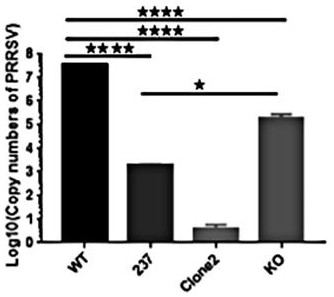A kind of gene sequence and application thereof for effectively inhibiting type II prrsv infection
A technology of gene sequence and base sequence, which is applied in the fields of application, genetic engineering, plant gene improvement, etc., can solve the problems of increased antibody dependence, rapid mutation of virus strains, etc., and achieve the effect of reducing huge losses
- Summary
- Abstract
- Description
- Claims
- Application Information
AI Technical Summary
Problems solved by technology
Method used
Image
Examples
Embodiment 1
[0024] Preparation of gene sequence capable of effectively inhibiting type II PRRSV infection as shown in SEQ ID 1
[0025] 1) Call out the porcine CD163 gene sequence in the NCBI gene bank;
[0026] 2) Use the Primer5 software to design the upstream primer F1 and downstream primer R1 with base sequences as shown in SEQ ID 3 and SEQ ID 4 respectively;
[0027] 3) Utilize the PCR in vitro amplification method to obtain the target gene sequence whose base sequence is shown in SEQ ID 1;
Embodiment 2
[0029] 1-1. Design of sgRNA sequence and construction of PX330 expression vector
[0030] Two sgRNA sequences targeting porcine CD163 exon7 were designed and synthesized. The sgRNA sequence designed above was synthesized; the DNA sequences of the four single-stranded sgRNAs were annealed to form two oligonucleotide chains targeting different sites of the porcine CD163 exon7 oligonucleotides; and then the oligonucleotides were connected into the PX330 plasmid vector.
[0031] The sequences of these two sgRNAs and the sequences of their action sites are:
[0032] SgRNA-1 sequence: 5-GGAAACCCAGGCTGGTTGGA-3
[0033] The sequence of the sgRNA-1 action site: 5-TCCAACCAGCCTGGGTTTCC-3
[0034] SgRNA-2 sequence: 5-GAGTAGCACCCCCGCCCTGAC-3
[0035] The sequence of the sgRNA-2 action site: 5-GTCAGGGCGGGGTGCTACTC-3
[0036] Among them, the present invention involves
[0037] The RNA sequence of sgRNA-1 is: 5-GGAAACCCAGGCUGGUUGGA-3
[0038] The complementary sequence of the RNA seque...
Embodiment 3
[0045] Construction of homologous targeting vector
[0046] According to the screened high-efficiency sgRNA and construct a homologous targeting vector matching the sgRNA (sequence shown in SEQ ID19), the main components of the targeting vector are: the upstream homology arm whose sequence is shown in SEQ ID 7, and the pig sequence The fifth exon of CD163 shown in SEQ ID 1, the downstream homology arm shown in SEQ ID 10 and the backbone vector for prokaryotic expression. The site-specific integration targeting plasmid and the screened sgRNA can be used to carry out specific genetic modification on the porcine CD163 exon7 site, and then combined with PCR and RFLP methods can easily analyze the integration and expression of foreign genes at the sgRNA recognition site feasibility. The base sequence of the site-directed integration targeting vector constructed in the present invention is consistent with SEQ ID 19.
PUM
 Login to View More
Login to View More Abstract
Description
Claims
Application Information
 Login to View More
Login to View More - Generate Ideas
- Intellectual Property
- Life Sciences
- Materials
- Tech Scout
- Unparalleled Data Quality
- Higher Quality Content
- 60% Fewer Hallucinations
Browse by: Latest US Patents, China's latest patents, Technical Efficacy Thesaurus, Application Domain, Technology Topic, Popular Technical Reports.
© 2025 PatSnap. All rights reserved.Legal|Privacy policy|Modern Slavery Act Transparency Statement|Sitemap|About US| Contact US: help@patsnap.com



